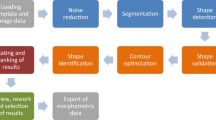Abstract
We describe tools for automatic identification and classification of diatoms that compare photographs with other photographs and drawings, via a model. Identification of diatoms, i.e. assigning a new specimen to one of the known species, has applications in many disciplines, including ecology, palaeoecology and forensic science. The model we build represents life cycle and natural variation of both shape and texture over multiple diatom species, derived automatically from photographs and/or drawings. The model can be used to automatically produce drawings of diatoms at any stage of their life cycle development. Similar drawings are traditionally used for diatom identification, and encapsulate visually salient diatom features. In this article, we describe the methods used for analysis of photographs and drawings, present our model of diatom shape and texture variation, and finish with results of identification experiments using photographs and drawings as well as a detailed evaluation.
Similar content being viewed by others
References
du Buf H., Bayer M.M. ed. (2002) Automatic Diatom Identification. vol. 51, Series in Machine Perception and Artificial Intelligence, World Scientific, Singapore
Chang K., Ghosh J. (2001) A unified model for probabilistic principal surfaces. IEEE Trans. Pattern Anal. Mach. Intell. 23(1): 22–41
Goldman N., Paddock T.B.B., Shaw K.M. (1990) Quantitative analysis of shape variation in populations of Surirella fastuosa. Diatom Res. 5, 25–42
Gonzalez R.C., Woods R.E. (1993) Digital Image Processing. Addison-Wesley, Reading
Hastie T., Stuetzel W. (1989) Principal curves. J. Am. Stat. Assoc. 84(406): 502–516
Hicks Y.A., Marshall A.D., Rosin P.L., Martin R.R., Bayer M.M., Mann D.G. (2002) Modelling life cycle related and individual shape variation in biological specimens. Proc. BMVC 1, 323–332
Mann D.G., Droop S.J.M. (1996) Biodiversity, biogeography and conservation of diatoms. Hydrobiologia 336, 19–32
Mann D.G. (1999) The species concept in diatoms (Phycological Reviews 18). Phycologia 38, 437–495
Mou D., Stoermer E. (1992) Separating Tabellaria (Bacillariophyceae) shape groups based on fourier descriptors. J. Phycol. 28, 386–395
Murthy S., Kasif S., Salzberg S. (1994) System for induction of oblique decision trees. J. Artif. Intell. Res. 2, 1–32
Rifkin, R. SvmFu package. Available from http://five-percent-nation.mit.edu/SvmFu/
Round F.E., Crawford R.M., Mann D.G. (1990) The diatoms. Biology and Morphology of the Genera. Cambridge University Press, Cambridge
Stoermer, E.F., Ladewski, T.B. Quantitative Analysis of Shape Variation in Type and Modern Populations of Gomphoneis herculeana. 73, 347–386, Nova Hedwigia, Beih (1982)
Zahn C.T., Roskies R.Z. (1972) Fourier descriptors for plane closed curves. IEEE Trans. Comput. c-21(3): 269–281
British Diatomists of the 19th Century database. Available at http://rbg-web2.rbge.org.uk/DIADIST/dia_intro.htm
Author information
Authors and Affiliations
Corresponding author
Rights and permissions
About this article
Cite this article
Hicks, Y.A., Marshall, D., Rosin, P.L. et al. A model of diatom shape and texture for analysis, synthesis and identification. Machine Vision and Applications 17, 297–307 (2006). https://doi.org/10.1007/s00138-006-0035-1
Received:
Accepted:
Published:
Issue Date:
DOI: https://doi.org/10.1007/s00138-006-0035-1




